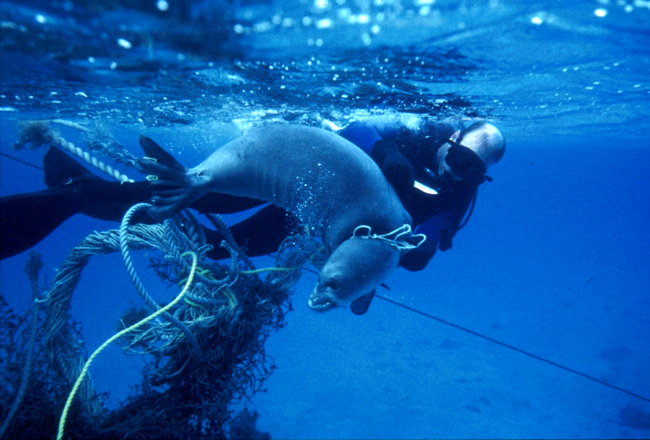 |
| Crab pot buoys, usually found as marine debris. |
Last night I attended a presentation coordinated by the American Cetacean Society (ACS) on marine life entanglements. The presentation was given Kathi Koontz who works with the Marine Mammal Center on the Whale Entanglement Team. She is part of a group that responds to reports and sightings of entangled whales along the California coast. A very cool weekend job—I’m extremely jealous!
First, what sort of debris and objects are found on entangled animals? Mostly fishing line, fishing nets, various ropes, crab pots, buoys, fan belts, and much more. The majority of this material is made of plastic, which will not degrade or lose its shape and therefore causes significant damage.
Most of this debris is picked up by the animal and dragged for hundreds and hundreds of miles before the animal may be disentangled. Whale entanglement teams in Hawaii have reported findings of Alaskan fishing gear from the Bering Sea on entangled whales.
In some cases, debris may weigh a whale or other animal down so it cannot surface or cannot move. Other times attached buoys can slow down whales and not allow them to dive underwater.
It was reported at the meeting that 50 percent of the sighted marine animals possess scars from entanglement.
 |
| © Alberto Romeo/Marine Photobank |
The whole disentanglement business started at the
Center for Coastal Studies to help free-swimming humpback whales and North Atlantic right whales off the Eastern United States coast.
A variety of specially designed gismos and gadgets are used to cut off the entanglements without harming the whale. If the disentanglement team cannot remove the debris, they may attach a telemetry buoy that will track the animal’s location so they may find it another day and try again.
Back in the days when gillnet fishing was allowed between the Farallones and the California coast, harbor porpoises were caught in the hundreds in the gillnets. Fishermen used to pull them up out of the water and cut off their fins and flukes to let them loose. Naturally, they would then die at sea and wash up onshore. The fishermen would rather kill thousands of animals instead of cut up their precious fishing nets.
Now that these gillnet fisheries have been outlawed in the area, the harbor porpoises are slowly coming back to the San Francisco Bay. Yay! See? This isn't just a lost cause, by preventing entanglement we could see positive change in our marine ecosystems.
Just last August the Whale Entanglement Team out here in California went in search of a reported entangled humpback whale off the coast of Mendocino. Instead, the team found an entangled gray whale with a rope and buoy wrapped around its body, through its mouth, and over both pectoral fins and the peduncle (
the what?!). When the team tugged on the line to see if it would come lose on its own, they noticed that the line had severed the left pectoral fin. Eventually they were able to cut off the line, and the gray whale swam free; however, no sightings of a gray whale with a missing left pectoral fin have been reported since then so we don’t know what happened to the poor thing.
In the Farallones back in 2005, divers rescued a humpback whale that was caught by lines and crab pots and could not swim away.
Article here!
So far in 2011 there has only been one report of an entangled whale near Monterey, but no further sightings of the animal.
Entanglement is a problem with all animal species, not just whales, and not just marine animals. Birds may choke on bottle caps and balloons, or get caught in those plastic six-pack holders. Sea turtles, sharks, and seals may get caught in fishing gear.
The Marine Mammal Center also focuses heavily on entangled seals and sea lions along the California coast, who are often found with fan belts or fishing line wrapped around their necks and snouts so they are unable to feed or breathe properly. In one instance, they had rescued a sea lion with fishing line around its neck that had cut through its skin and severed its trachea. Another sea lion had line wrapped around its mouth so it was unable to feed.
Entanglement is just one type of human interaction that harms marine animals. Other forms of human interaction may be fishing bycatch, seal bombs, or even just people shooting at the animals with a gun. Not as uncommon as you think.
Also,
seal bombs. I hadn’t heard about seal bombs until last night. People throw bombs at seals to scare them away. And also accidentally blow them up. The following quote is from the
Friends of Animals website:
To catch fish, people have used explosive devices, hoping to deter marine mammals from interfering with their equipment or catch. Seal bombs still cripple those they are meant to deter… Seal bombs are small pieces of dynamite that can detonate under water. Often, a seal bomb is placed inside a fish and fed to a sea lion – even though deliberately using seal bombs to harm marine life is prohibited.
So please, if you would like to help out:
- Cut up circular pieces of plastic and trash so that it cannot be caught around an animal’s neck.
- Participate in beach cleanups to remove hazardous debris, or bring your own trash bag to fill up when you go to the beach.
- Reduce your plastic use.
- Be responsible for your fishing gear—don’t let it float away. Clean up all of your fishing lines and nets.
- Don’t buy balloons.
- Volunteer at a marine mammal center!
- Spread the word.
































